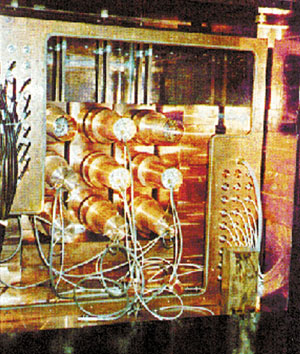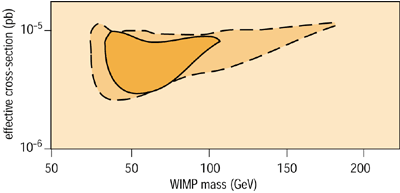At the Italian Gran Sasso National Laboratory, a novel experiment that is in search of signs of the invisible dark matter that pervades our universe reports an intriguing result.

A large part of the dark matter that seems to dominate the universe is expected to be in the form of relic particles. This “dark universe” could be a unique window through which we will be able to look for new physics. The DAMA experiment at the INFN Gran Sasso National Laboratory is investigating this new frontier and sees an annual variation, which is suggestive of the Earth’s motion against a background “wind” of particles.
Particles from the dark universe
Measurements of luminous matter (stars) lead to the conclusion that the universe does not contain enough stellar matter to halt the residual Big Bang expansion. Without enough such gravitational braking, the universe will continue to expand forever. However, many experimental observations suggest that luminous matter is not the end of the story. To account for the observed motion in the cosmos, gravitational fields much stronger than those attributable to luminous matter are required more than about 90% of the mass in the universe should be the result of invisible dark matter.
This conclusion is further supported by simulations using cosmological models that point out the necessity for large numbers of relic particles weakly interacting massive particles (WIMPs) from the early universe.
This scenario implies that our galaxy should be completely embedded in a large WIMP halo. Our solar system, which is moving with a velocity of about 232 km/s with respect to the galactic system, feels a continuous WIMP “wind”.
The quantitative study of this wind would provide information on the evolution of the universe and investigate new physics possibilities. The lightest neutral particle (the neutralino) expected by the supersymmetric extension of the Standard Model is the best WIMP candidate.
How to catch a WIMP?
Direct detection of WIMPs is very difficult because they rarely interact. WIMP searches should be shielded from cosmic rays and operate in an environment of very low radioactivity. The detectors should be built using low-radioactive materials.
DAMA’s home is deep underground in the INFN Gran Sasso National Laboratory in Italy. The collaboration (involving the University and INFN-Roma2, University and INFN-Roma, IHEP-Beijing) is mainly devoted to the search for WIMPs in the same mass and cross-section region as accelerator experiments, and several results have already emerged.
Thus high-atomic-number target nuclei, such as iodine (in the form of NaI(Tl)) and xenon (in the form of a liquid xenon scintillator) are used. The search mainly focuses on WIMPnucleus elastic scattering from the target-nuclei part of the detector, which would show up via nuclear recoil energies in the kilo-electronvolt range.
To help to isolate a possible WIMP signal from the background, the main feature of the WIMP wind is its annual modulation. As the Earth rotates around the Sun, it would be crossed by a higher WIMP flux in June (when its rotational velocity is in the same direction as that of the solar system with respect to the galaxy) and by a smaller one in December (when the two velocities are subtracted). The fractional difference of the rate is some 7%.
To see such modulation requires heavy, stable detectors with appropriate features and stability control. The 100 kg highly radiopure NaI(Tl) DAMA set-up is an example. Clear signatures overcome the difficulties of comparing different experiments and techniques.
The 100 kg DAMA NaI(Tl) set-up
DAMA uses highly radiopure NaI(Tl) scintillators that are produced in collaboration with the CRISMATEC company. All of the materials and the crystal growth and handling procedures have been studied carefully. A major effort has gone into optimizing the detectors and the electronics to give a relatively high number of photoelectrons per kilo-electronvolt and a low noise level.
The low background photomultiplier tubes employed in the experiment (two for each detector, working in coincidence at a single photoelectron threshold) have been developed by Electron Tubes Ltd. The materials were preselected by the company and their radioactivity was measured deep underground.
The other main parts of the experiment are the passive shield (to exclude environmental contributions to the counting rate), which surrounds the copper box housing the detectors, and the glovebox placed on the top of the shield for calibration. The whole of the apparatus is kept in highly pure nitrogen with slight overpressure with respect to the atmosphere in order to keep out radioactive radon gas.
The materials of the shield have been selected and monitored for low radioactivity. The upper glovebox is used to insert radioactive sources to calibrate the detectors in the same experimental conditions as those occurring during the production measurements.
This set-up is mainly devoted to studies of WIMP annual modulation, therefore particular care has been taken in the stability and monitoring of the running condition parameters, such as the operating temperature, the high-purity nitrogen flux, the glovebox overpressure, the total and single hardware rates above single photoelectron threshold, the environmental radon level and so on. All of the information related to these parameters is continuously recorded with actual data.
The experiment is taking data from a single photoelectron threshold to several mega-electronvolts, although the hardware conditions are obviously optimized for the lowest energy region. Pulse shape information is recorded over a period of 3250 ns for the lowest energy events.
Searching for annual modulation
Any annual modulation of the WIMPnucleus differential energy spectrum should have all of the following features attributable to WIMP interactions:
- a modulation varying as a cosine function;
- a period of exactly one year;
- a proper summer-winter phase;
- only seen in a defined low-energy region;
- single “hit” events;
- a modulated amplitude below 7%.

Single-hit events with only one detector firing are the ones of interest in WIMP search, the probability of a WIMP interacting in more than one detector being negligible.
After checking the monitored parameters, the time-dependent component of the rate is extracted from the collected data by grouping the events in cells of one day, 1 keV and one detector. The number of events in each cell is then compared by applying a maximum likelihood analysis with the expectation from the standard WIMP model. The limit on the neutralino mass (the most favoured WIMP candidate) achieved at accelerators is taken into account.

The analysis of a first dataset suggested the possible presence of a signal compatible with the features of a neutralino with dominant spin-independent interaction. A second year of data taking with larger statistics has underlined this possibility. The signal modulation is shown in figure 1 and the neutralino interpretation in figure 2.
The combined analysis of these two years of data (total statistics: 19511 kg/day) provides a confidence level of 99.6% for a neutralino mass of 59 GeV (+17/14) and a proton cross-section of 7.0 (+0.4 /1.2) 10-6 pb in the frame of the standard WIMP model.
Possible systematic effects and alternative explanations have been investigated, as discussed for example at the 3K Cosmology International Conference in Rome last October. None of the effects considered could simulate all six of the criteria for the annual modulation signature and provide the observed modulation.
Despite this the collaboration has been very cautious mindful of the difficulties of dealing with rare events and has increased its efforts to investigate all aspects of this intriguing result.
The region singled out by DAMA is consistent with the hypothesis of a relic neutralino as a dominant component of the cold dark matter in the galactic halo, as has been pointed out by a Turin group, which also says that some properties of the relevant supersymmetric particles should be accessible at present accelerators and in WIMP indirect searches.
The inclusion of these relic neutralinos in supergravity models hs also been considered by American physicists. A group from Rome and Moscow suggested that the effect could be the result of a heavy neutrino. Finally, the effect of the uncertainties on the dark halo local density and on the WIMP velocity distribution has been examined recently with the conclusion that the relic neutralinos possibly involved in the annual modulation effect would have a mass in the 30130 GeV range with an upper bound extending to some 180 GeV when possible bulk rotation of the dark matter halo is introduced.
Perspectives and plans
The analysis of further statistics is in progress as well as further data taking and an upgrade of the apparatus. If new research for the improved radiopurification of NaI(Tl) is successful, the active mass could be increased to 250 kg.
A final result would mean reproducing the effect over several annual cycles, including all tof he consistency checks.





